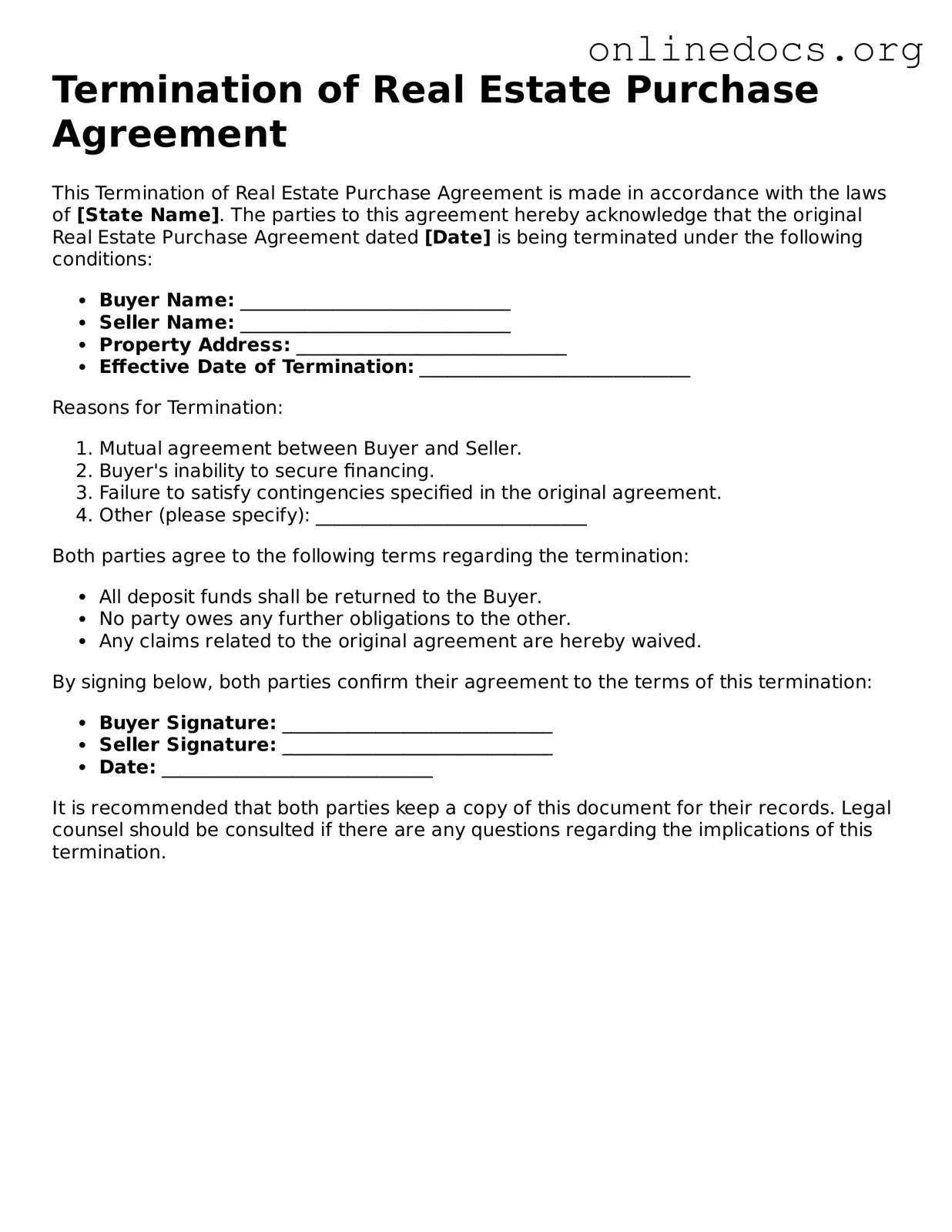The Termination of Real Estate Purchase Agreement form bears similarities to the Cancellation of Lease Agreement. Both documents serve the purpose of formally ending a contractual relationship. In the case of a lease, the tenant and landlord may agree to terminate the lease before its expiration date. Just like the termination form for a purchase agreement, the cancellation of a lease requires the consent of all parties involved to ensure that no further obligations remain. This mutual agreement helps prevent potential disputes and clarifies the finality of the decision.
Another document akin to the Termination of Real Estate Purchase Agreement is the Release of Liability form. This form is often used when parties wish to free themselves from any future claims related to a specific agreement. Similar to the termination form, the Release of Liability ensures that both parties acknowledge the end of their contractual obligations and agree not to pursue any claims against each other. This mutual release fosters a sense of closure and helps protect the interests of both parties moving forward.
The Mutual Release Agreement also shares characteristics with the Termination of Real Estate Purchase Agreement. This document is used when two parties decide to release each other from obligations under a contract. Both forms require clear communication and agreement on the terms of the release. In essence, they both aim to prevent future misunderstandings and disputes by clearly outlining the end of the relationship and the responsibilities of each party.
The Withdrawal of Offer form is another document that resembles the Termination of Real Estate Purchase Agreement. When a buyer decides to withdraw their offer on a property, this form is utilized to formally communicate that decision. Just as the termination form signifies the end of a purchase agreement, the Withdrawal of Offer serves as a way to notify the seller that the buyer is no longer interested. Both documents emphasize the importance of clear communication and mutual consent in real estate transactions.
Understanding the various agreements related to real estate transactions is crucial for both buyers and sellers. One such essential document is the New York Real Estate Purchase Agreement, which serves as a foundation for any property transaction. For those looking to familiarize themselves with this agreement and ensure they have all the necessary information, resources like nyforms.com/real-estate-purchase-agreement-template can be invaluable in guiding them through the process.
Similarly, the Notice of Default is a document that can relate to the termination of a real estate agreement. This notice is typically issued when one party fails to meet their obligations under a contract. While the Termination of Real Estate Purchase Agreement signifies a mutual decision to end the agreement, the Notice of Default serves as a precursor to potential termination. It highlights the importance of fulfilling contractual obligations and provides a formal way to address any issues before proceeding with termination.
The Settlement Agreement also shares similarities with the Termination of Real Estate Purchase Agreement. This document is often used to resolve disputes between parties and finalize the terms of their separation. Both forms require negotiation and agreement on the terms of the separation. A Settlement Agreement outlines the responsibilities of each party moving forward, while the termination form confirms the end of the relationship. Both are essential for ensuring that all parties are on the same page and understand their rights and obligations.
The Termination Notice is another document that aligns closely with the Termination of Real Estate Purchase Agreement. This notice is typically used to inform one party that the other intends to terminate a contract. Like the termination form, it serves as an official communication that signifies the end of a contractual relationship. Clarity and precision in wording are crucial in both documents to avoid misunderstandings and ensure that all parties are aware of the decision.
Lastly, the Amendment Agreement can also be seen as similar to the Termination of Real Estate Purchase Agreement. While an amendment modifies an existing contract, both documents require the agreement of all parties involved. The amendment can change specific terms or conditions, while the termination form ends the agreement entirely. Both processes emphasize the importance of collaboration and mutual consent in real estate transactions, ensuring that all parties are satisfied with the outcome.
